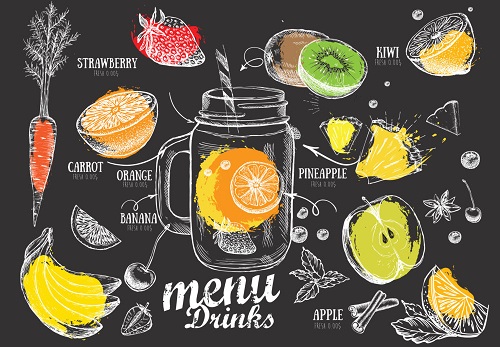Juice Bars Adapting to New World of Fitness & Health

What is the future of the juice bar? Has the increase of at-home beverages made the juice bar irrelevant? While the future isn’t entirely clear, it’s definitely something to sip on.
Juice and smoothie bars emerged in dramatic fashion over the last decade or so, often popping up nearby or even within gyms and fitness studios. But just as kale smoothies and juice cleanses started to move from the fringes of health-conscious consumption to more mainstream daily living, the COVID-19 pandemic threw the industry a curveball.
On one hand, the pandemic caused many gyms to close, at least temporarily. Those that have re-opened may not be able or want to have a cafe serving gym-goers indoors. Likewise, juice and smoothie bars located near gyms may be losing valuable foot traffic due to a drop in gym patronage. Plus, consumers who have been affected by the economic fallout from the pandemic may not be willing to shell out upwards of $10 for a post-workout drink.
On the other hand, COVID-19 has coincided with a number of changes that bode well for this industry. A marketing manager at a gym in Downtown Austin says a neighboring smoothie bar has been booming during the pandemic.
One reason why some juice and smoothie bars are thriving is that many of these locations are takeout-friendly, which fits the moment well. Consumers may not be dining out as much, but they can still swing by a smoothie store to grab a healthy drink. And while many people have been struggling economically, those who have been able to keep their jobs may find themselves with fewer places to spend their disposable income. So, dropping money on these drinks may not seem to make as much of a dent in their wallets as it did in the past.
Moreover, the pandemic may arguably spur more long-term shifts around the areas of health, fitness and community. Juice and smoothie bars (along with the fitness brands they partner with) that can adapt to meet these changing times could have much to gain.
Healthy Habits
Many consumers are now more focused on their health and wellness than in the past. While they may have limited control over the broader health crisis, they can take accountability for their own actions. To try to feel better physically and/or mentally, consumers are often paying closer attention to what they put in their bodies.
“People have, I believe, started to take a whole new approach to their health in the last year,” says Annie Sullivan, owner of Bliss, a juice and smoothie bar in the Hudson Valley outside of New York City. “I see it as more preemptive care people are taking for themselves and their family — feeding ourselves organic produce in whole and liquid form is an incredible way to keep our bodies healthy and strong.”
Turning to Takeout and Delivery
As mentioned, consumers may be more willing or only have the option to get a takeout or delivery smoothie rather than passing time in a cafe. So, those that have pivoted to areas like faster takeout, mobile ordering, delivery and bottled options have often seen success. Large franchises like Smoothie King and Tropical Smoothie Cafe continued to grow in 2020, in part due to their ability to leverage digital ordering platforms.
Independent shops like Bliss have also adapted. Sullivan, the former shop manager for Bliss’s predecessor, Nourish, took over the business during the middle of the pandemic in June 2020. A few months later, she rebranded the store to Bliss and renovated “from an open-kitchen cafe with indoor dining to a closed-kitchen space, with take-out only,” she explains. “The changes we made were 100% focused on safety, and we installed a pick-up window for easy pick up from online ordering.”
With these changes in place, Bliss has been able to withstand the loss of crowds from nearby fitness studios, some of which have permanently closed. But since Sullivan took over in June, she says her business has rebounded strongly.
Other brands like Daily Harvest and Catalina Crunch, which are based around delivering smoothies and other healthy items for at-home consumption, can also appeal to consumers. Yet don’t go writing off juice and smoothie bars due to these at-home options.
Wine-of-the-month clubs have far from taken down wine stores; Keurig machines have not spelled the end of coffee shops. New innovations and means of consumption have emerged across sectors, but it doesn’t have to be a zero-sum game. While juice and smoothie bars may have to provide more convenience to thrive in this new, on-demand era, there can be room for multiple types of business in this space.
Sweating More at Home
Many people have also kicked their home workouts into high gear, prompting new opportunities for juice and smoothie brands — both those that exclusively focus on at-home consumption as well as more traditional cafes.
For example, Kite Hill, which sells a variety of plant-based dairy alternatives, recently partnered with Ally Love, whose many roles include being a Peloton instructor and an Adidas global ambassador. The duo’s collaboration has included creating a new recipe for a plant-based smoothie.
Juice and smoothie bars can also help facilitate at-home workouts by being flexible to evolving demand and making changes accordingly.
“I think having at-home workout schedules has caused an increased desire of taking products/smoothies home for the next day,” says Sullivan of Bliss. “We are working on developing a line of bottled beverages that are house-made protein blends, similar to smoothies, that keep well in the refrigerator. Some customers even ask for smoothie ingredients to be pre-portioned and packaged for blending at home.”
When gyms and fitness studios resume normal operations, they too may be able to get in on this trend. The rise of hybrid offerings, such as where gyms offer on-demand classes alongside traditional memberships, could extend to helping consumers get the nutrition they’re looking for at home.
Sullivan notes that she has partnered with a nearby Pilates studio for juice cleanses in the past and hopes to do so in the future too.
Seeking Community
While hybrid gym memberships may continue after the pandemic ends, there’s still significant potential for juice and smoothie bars to thrive within or nearby fitness businesses.
One reason is that the rise of remote work will likely continue long-term. Even though many will do so by choice, that will in turn drive these workers to look for other opportunities for socialization outside of work, which gyms can provide, says John Atwood, founder and managing partner of Atwood Consulting, which advises businesses in the fitness industry. “Gyms are going to become more of a community.”
One area where that community could be fostered could be within juice and smoothie bars, where gym-goers can relax and talk to other members after working out. For many gyms, juice bars aren’t necessarily huge profit drivers but more so provide a nice amenity to members, says Atwood.
So, that perk could become even more valuable for fitness businesses looking to get customers back after the pandemic.
“I think the vast majority of people will be going back to clubs despite [at-home workouts], and I think they’re going to use clubs as more of a hub of socialization than ever before.”
For juice and smoothie bars, that could mean being able to lean into both sides of the convenience/community spectrum would be an asset. Or, it could signal that there’s an opportunity for different types of juice and smoothie businesses to thrive.
At times, customers may still want the speed of takeout and delivery they’ve grown accustomed to, which will benefit some cafes oriented in this direction, along with brands like Daily Harvest. At other times, customers may want to congregate more, creating opportunities for juice and smoothie bars that have more of a cafe feel, including for those within gyms. Or, fitness brands may want to allow customers to bring in drinks from nearby stores or find other ways to partner with these businesses to help create community.
While the direction of the juice and smoothie bar of the future isn’t entirely clear, these businesses and the fitness brands they coexist with don’t have to get squeezed out permanently. The potential to turn this lemon of a pandemic into lemonade is real.



